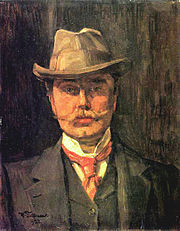Wilhelm Trübner's Human Design Chart
2/4 Sacral GeneratorWilhelm Trübner: A Master of Realism and Human Design
Early Life and Artistic Beginnings
Born on February 3, 1851, in Heidelberg, Germany, Wilhelm Trübner emerged as a prominent figure in German realism. His early life in the culturally rich city of Heidelberg undoubtedly influenced his artistic sensibilities. Trübner was born under the Human Design profile of a Generator with Sacral Authority, which would later play a crucial role in his artistic journey.
The Human Design Influence
Trübner’s Human Design as a Generator with the Strategy “To Respond” means that he thrived on responding to life as it came to him, rather than initiating action. This approach is evident in his painting style, where he allowed his work to evolve naturally, responding to the canvas and the colors he used. His Sacral Authority guided him to trust his gut feelings in artistic decisions, leading to authentic and inspired creations.
His Profile of 2/4, known as the Hermit/Opportunist, suggests that Trübner balanced a need for solitude to perfect his craft with an inclination to share his work with the world through opportunities that came his way. This was reflected in his role within the Berlin Secession, where he combined solitary creative processes with public exhibitions.
Artistic Philosophy and Achievements
Trübner was a key figure in the circle of Wilhelm Leibl, contributing significantly to the German realist movement. In 1892 and 1898, he published writings on art theory, emphasizing that “beauty must lie in the painting itself, not in the subject.” This philosophy aligns with his Incarnation Cross: Right Angle Cross of The Sphinx (13/7 | 1/2), which drove him to seek and express beauty from within the work itself, rather than external inspirations.
His Channels, such as “7-31” and “13-33”, supported his ability to lead and express himself with clarity, while “28-38” and “3-60” channeled his intuitive sense of timing and persistence in overcoming obstacles, allowing him to innovate within the confines of realism.
The Berlin Secession and Academic Influence
In 1901, Trübner joined the Berlin Secession, Germany’s foremost avant-garde art exhibition group of the time. His involvement provided a platform to express his unique artistic voice, aligning with his Human Design’s need to respond to external stimuli and opportunities.
From 1903 until his death in 1917, Trübner served as a professor at the Academy of Arts in Karlsruhe. His tenure as director from 1904 to 1910 allowed him to influence and nurture a new generation of artists, reflecting the mentor aspect of his 2/4 profile.
Legacy and Impact
Wilhelm Trübner passed away on December 21, 1917, in Karlsruhe, Germany. His legacy as a pioneer of realism and a proponent of “art for art’s sake” continues to inspire artists. His Human Design, characterized by his Generator energy and strategic responses, underlies his life’s work and artistic contributions.
Trübner’s ability to balance personal creativity with public engagement exemplifies the harmonious interplay of his Human Design elements, leaving an indelible mark on the art world.
Discover More Famous People
Browse and analyze over 55,000 public figures and celebrities.
Ra Uru Hu
5/1 Manifestor
Martha Stewart
4/6 Manifestor
David Lynch
4/6 Generator
Barack Obama
6/2 Projector
Steve Jobs
6/3 Generator
Vladimir Putin
5/1 Manifestor
Kim Kardashian
3/5 Generator
Michael Jackson
1/3 Projector
Marilyn Monroe
6/2 Projector
Ariana Grande
2/4 Projector
Oprah Winfrey
2/4 Generator
Johnny Depp
2/4 ManifestorWhat is HumanDesign.ai and how does it work?
Curious what makes Wilhelm Trübner tick? HumanDesign.ai instantly maps their exact birth data into a fully interactive clickable bodygraph chart, letting you hover or tap every center, channel, and gate for plain-language explanations. Bella, the platform’s built-in AI guide, adds context in real time, translating complex mechanics into everyday insights so you can see how Wilhelm Trübner’s strengths, challenges, and life themes play out on-screen.
The same tools are waiting for you. Generate your own Human Design Chart in seconds, open a library of 2000+ suggested questions, and chat with Bella as often as you like to decode your design, daily transits, and even relationship dynamics.
Want to compare energies? Save unlimited charts for friends, family, or clients, then ask Bella to reveal compatibilities, composite patterns, or coaching tips, all in one conversation thread.
Start free with core features, or unlock our Personal and Pro plans for deeper dives: unlimited Q&A, celebrity chart search spanning 55,000+ public figures, white-label PDF reports, branded content generation, and a professional profile with built-in booking for practitioners. Whether you’re exploring your own potential or guiding others, HumanDesign.ai delivers an ever-expanding toolbox of AI-powered insights—no spreadsheets, no jargon, just clarity at your fingertips.
Ready to see yours? Signup for FREE today!

